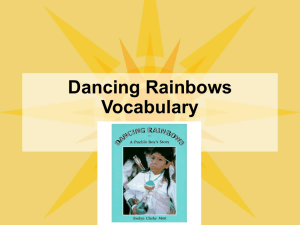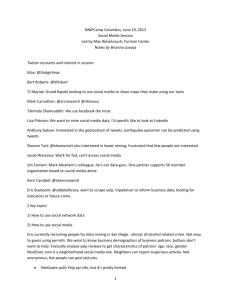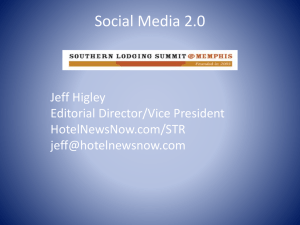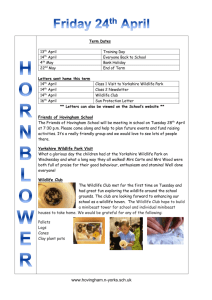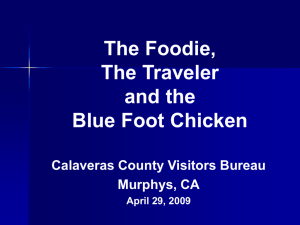View Business Plan - Digital Media Entrepreneurship
advertisement
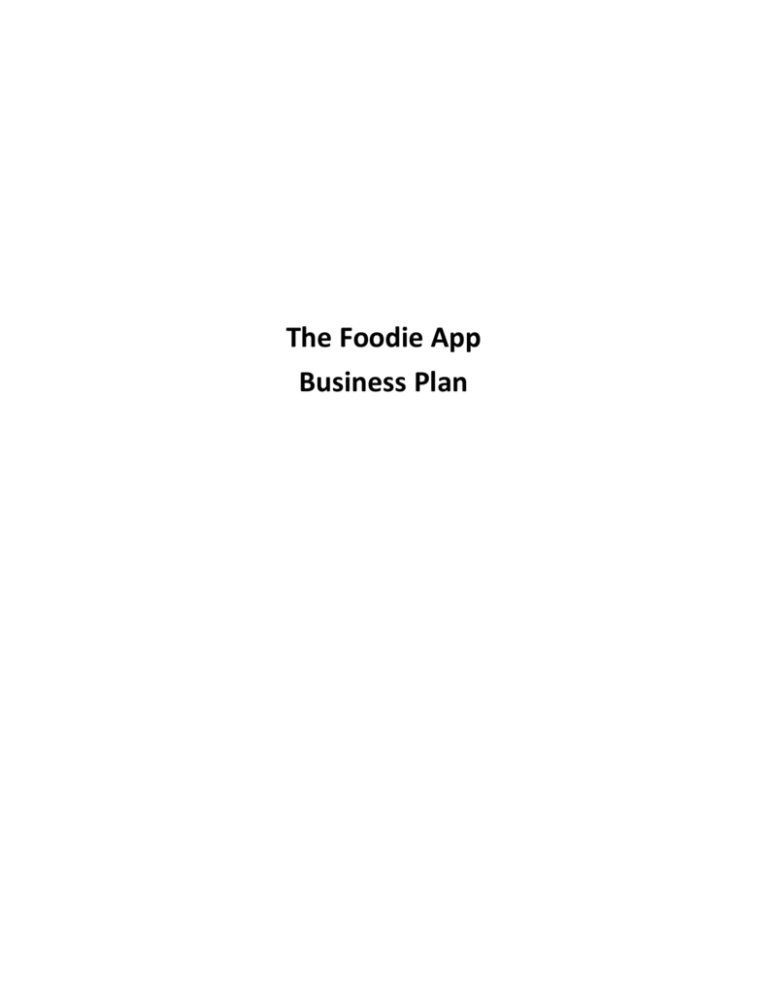
The Foodie App Business Plan 1. Foodie - Business Plan Executive Summary Foodie is a subscription-based restaurant review app that caters to and provides reviews from the foodie crowd. Problem As a digital service, Yelp is kicking some serious butt in the digital review space. The first quarter of 2015 brought $118.5 million in net revenue, reflecting a 55 percent growth over 2014’s first quarter1. Cumulative reviews have been growing 36 percent year over year, with Yelp now having approximately 77 million reviews, with a record six million coming in the last quarter alone. But in becoming a behemoth that has become the dominant player in the review app space, too much noise has become a problem2 . With anyone in the Yelp community able to contribute reviews, Yelp has become an app for the generalist. In regards to foods at restaurants, many of the reviews have become ambiance or service -- not necessarily the things that true foodies want to read or write about. Review have tended to be polarized, especially around ethnic foods3 that would require a more experienced palette to appreciate, or at the very least review. Solution Foodie serves the community that will best be served with lower noise -- the foodie community. Foodies are the ones who would be targeted to join the community, are the ones who would be most interested in each other’s opinions, and are the ones who would be most willing to pay a minimum subscription fee, which would serve as a barrier to keep the rest of the ‘noise’ out. Foodies are the people who would be the go-to source for restaurant recommendations offline, and Foodie aims to build a community of such foodies to benefit from one another’s reviews. Using a similar model as Yelp that has proven to be popular, Foodie aims to decrease the ‘noise’ by generating reviews by foodies for foodies. Business Model The small subscription fee would not only create an earned revenue stream, it would also serve to create the barrier of keeping ‘noise’ out of the community, which would then consist of users who are serious about food enough to pay a small fee for an app. The small earned revenue stream would exist from the onset, but then the controlled but valuable community would be able to be monetized in other ways, namely with native advertising content that is directed toward the foodie crowd. Foodie is fortunate enough to be from the backyard of San Francisco, which is as tech-savvy and foodie-filled as any major city in the world. After establishing the model and community in San Francisco, Foodie could then be scaled and replicated to other major cities in the United States. 1 http://www.yelp-ir.com/phoenix.zhtml?c=250809&p=irol-newsArticle&ID=2041788 http://www.eater.com/2013/9/26/6364287/16-of-yelp-restaurant-reviews-are-fake-study-says 3 http://www.ischool.berkeley.edu/newsandevents/news/20131004yelpdatasetchallenge 2 1 2. Company description The parent company behind the development of the Foodie App will be comprised of Johnny Winston (founder), Austin Meyer (co-founder), Nick Spears (co-founder) and Jay Lee (co-founder). The diverse team of Stanford students brings together a variety of product development and project management experience, as well as digital design and marketing skills, all with the aim of creating an app that creates and cultivates a digital community of food-loving folks through a subscription-based review app. 2.1 Mission Statement The Foodie App creates and cultivates a digital community of foodies who share and build off one another’s expertise. 2.2 Team Johnny Winston - Founder, Product Builder Johnny is currently pursuing his Masters in Computer Science at Stanford and focusing in Human-Computer Interaction. He’s passionate about mobile design and user experience and he has experience building conscientious online communities from his time at Patreon, a crowdfunding platform for artists. Austin Meyer - Co-Founder, Design Guru Austin is a master’s student in Journalism who studied English with an emphasis in creative writing as an undergraduate at Stanford. Austin is also an experience assistant at the Stanford design school where he teaches design classes and coaches student teams through the design thinking process. Nick Spears - Co-Founder, Marketing Maven Nick is a fourth year undergraduate student at Stanford University pursuing a degree in Science, Technology & Society. Having worked at a diverse array of companies including fashion company Helmut Lang and advertising firm H&L Partners, Nick has developed a comprehensive skill set that has prepared him for a career in entertainment working in brand coverage, PR, and celebrity relations. With entertainment and the culinary industry seeing extensive integration, Nick’s connections and expertise within both industries will serve Foodie well as the company penetrates new markets. Jay Lee - Co-Founder, Community Connecter Jay is a Stanford communications graduate student in the Journalism program. Previously, he worked for two-plus years at Major League Baseball Advanced Media, where he was an editorial producer managing the frontpage news content of MLB.com and the 30 official club websites. His experience there has given him the firsthand experience of cultivating digital community, and he has been passionately empowered by the ability of digital content to mobilize digital communities. 2 3. Product and Services 3.1 What will Foodie do? Foodie is a subscription mobile app that provides exclusive restaurant reviews. The app will include curated content from featured food critics and certified foodies, in addition to allowing users to submit their own reviews that will appear alongside those of critics. Foodie will be focusing on mobile and will provide a superior reviewing experience for the foodie on the go. Foodie will offer both a yearly subscription and also weekly travel passes for individual cities. 3.2 Profile of target user The target user are people living in cities making with $100,000 median household income (top 20% of US). The target use cares about food, wants high quality information they can trust, and wants to get access to that information quickly without sorting through clutter. They also might be frequent travelers who find themselves in new or unfamiliar cities. 4. Market analysis 4.1 San Francisco Bay Area Foodie will first aim to capitalize on the good fortunate of being developed within the San Francisco Bay Area, one of the world’s biggest culinary markets. Between San Francisco’s thriving food scene to Napa’s renowned restaurants, the market not only is strong for restaurants to review, but foodies to provide the reviews. The San Francisco Bay Area’s GDP of $535 billion4 would rank 19th in the world if it was its own country, and the growing economy and digital mobile market makes it an ideal place to pilot the app. Foodie will not only have being piloting in a market that is as filled with digital savvy mobile users as any other region globally, it will be aiming to penetrate a market that is comprised of individuals already reliant on mobile apps to optimize efficiency and effectiveness in their everyday lives. 4.2 Review app market Yelp’s explosion over the last 10 years into the dominant market leader in the review apps space actually creates the perfect climate for the introduction of Foodie into the market. Yelp’s gigantic growth -- now having approximately 77 million reviews and bringing in $118.5 million in net revenue in 2015’s first quarter -- now creates two opportunities for Foodie to enter in this already established market. First, Foodie would be targeting Yelp’s active users who would be the likely candidates to be disillusioned by the amount of noise within Yelp reviews and would be willing to pay the subscription fee to cross the barrier of entry into the community. WIth Yelp having more than 4 http://www.bayareaeconomy.org/bay­area­fast­facts/ 3 100 million unique users of their services, even getting a small fraction of that - 5 percent would still be a substantial user base. Second, Yelp for all its successes has not grown to be the profit-generating machine that was once projected as it expands its operations. The first quarter of 2015 shows that its growth was slowing, and its stock prices have been falling5 . The year-over-year projected sales growth of 49% for the second quarter, would also be Yelp’s weakest since its IPO in March 2012. Rumors have been circulating that Yelp will be up for sale6 , with Facebook, Google, Amazon and other major companies being in the running as potential buyers. If Yelp is indeed sold to a major company that is seeking to integrate Yelp’s features into its own products and networks, that would provide the opportunity for other players to enter the market and take over for Yelp’s service, especially at the specialty niche level. 4.3 Digital services within restaurant market The restaurant space has also shown to be strongly inclined to digital, specifically mobile services. Foodie’s advantage will be that it will start as a mobile-based service, optimizing the app and its user experience from the very beginning, where a lot of consumer-facing products within this space (such as Yelp) have started on desktop before transitioning to mobile, with such organizational hierarchy apparent in the products. In 2015’s first quarter, Yelp reported an increase of 29% with mobile users, while unique desktop visitors fell 3%, showing that the trend is moving towards mobile being the future of online reviews. Reviews aren’t the only ways restaurants interact with consumers digitally, with online reservations also growing as a service. OpenTable is one such provider of services, and more than 32,000 restaurants worldwide use OpenTable, and 47% of OpenTable’s users booked reservations on a mobile device7. 5. Strategy and implementation 5.1 Initial users Initial users will be carefully chosen to be tastemakers (food bloggers, chefs, critics, people with large social media followings, yelp elite) in the community. This will ensure that the platform will continue to be an exclusive and desirable community. We will also pay certain users to create content for the site, and we will waive the subscription fee for some users but not provide further compensation. Aside from users that we are compensating to use the site, we will also have users that join the site for the content itself and who will pay the subscription fee. 5.2 Growth Because this is a subscription app, we do not have to have as many users as ad-supported 5 http://www.wsj.com/articles/yelp­reports­slower­growth­of­average­monthly­unique­visitors­1430340912 http://www.wsj.com/articles/yelps­hardest­sell­yet­1431453085 7 http://press.opentable.com/ 6 4 platforms like yelp. We’d like to start with 100 beta users on day 1 and grow 21% month over month (this is on par with what Paul Graham has seen as a successful growth rate during Y combinator). Date Users start 100 Month 1 121 Month 2 146 Month 3 177 Month 4 214 Month 5 259 Month 6 314 Month 7 380 Month 8 459 Month 9 556 Month 10 673 Month 11 814 Month 12 985 Month 13 1,192 Month 14 1,442 Month 15 1,745 Month 16 2,111 Month 17 2,555 Month 18 3,091 Month 19 3,740 Month 20 4,526 Month 21 5,476 Month 22 6,626 Month 23 8,018 Month 24 9,702 Month 25 11,739 Month 26 14,204 Month 27 17,187 Month 28 20,797 5 Month 29 25,164 Month 30 30,448 Month 31 36,842 Month 32 44,579 Month 33 53,941 Month 34 65,268 Month 35 78,975 Month 36 95,559 6. Financials 6.1 Startup Costs As Foodie begins by bootstrapping through incubation in a Stanford course, the startup costs moving forward would seek to cover the operating costs of the first two years, as well as the expansion of the team to bring in the necessary engineering talent to develop the product. 6.2 Subscription price point Setting of the price point for the subscription to enter the Foodie community and use the Foodie app will be crucial in determining Foodie’s success. Too low a barrier may allow too many people and dilute the community, while too high may not allow the community to grow in an optimal way. Right now, Foodie is basing projections off a $5/month subscription fee. 6.3 Forecasts Year 1: ● ● ● Year 2: ● ● ● Year 3: ● ● ● Launch in San Francisco 1,000 users $60,000 yearly revenue Launch in Portland, Seattle, Boston 10,000 users $600,000 yearly revenue Launch in New York, Los Angeles, Paris, London, Barcelona, Rome 100,000 users $6,000,000 yearly revenue 7. Funding 6 We are looking to raise a $2 million dollar seed stage round for 25% equity. We need to pay 2 iOS developers $110k a year each. Each of the founders will be paid $90k a year. We will need to bring on a designer for $100k a year. We are also looking to give away a 5% equity stake to a chef/critic branding partner. We need office space which will cost $100k a year. $200k a year will be used to pay critics to write content for us and to use in marketing. This money will allow us to run for 2 years, at which point we hope to have 10,000 users, $600k in revenue, and raise a series A. 7
